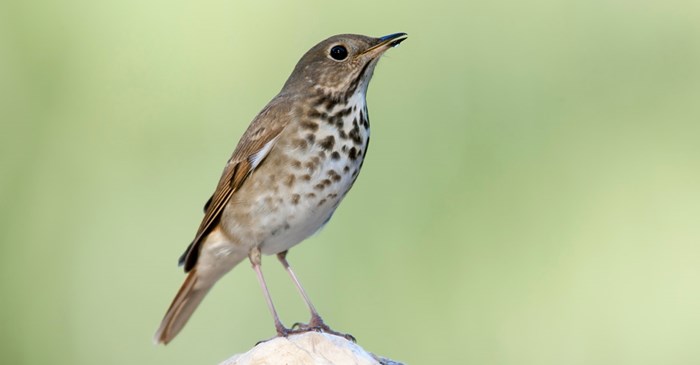Thrushes have a richly deserved reputation for singing the most beautiful, heart-stirring melodies in the songbird repertoire, and the Hermit Thrush is no exception. Those who spend their springs and summers hiking, camping and recreating in the Rocky Mountains or the forests of Vermont will want to keep an ear out for its haunting melody ringing through the trees
What does a Hermit Thrush look like?
The Hermit Thrush is closely related to two other well-known American bird species, the American Robin and the bluebird. They all share a similar shape and profile, from the wide ringed eyes and chunky body, down to the long tail. Compared to the robin and bluebird, the Hermit Thrush is slightly diminutive, with a more plain appearance, featuring a brown body, speckled breast, and reddish tail. It stands with its beak upturned, lending it a pert, inquisitive expression.
Where does the Hermit Thrush live?
During warm weather months, the Hermit Thrush breeds, forages and dwells in the forests of the far northern U.S.: in the Rocky Mountains and throughout much of Canada. When the fall migration season comes about, it flies by nighttime heading for the southern U.S., where the food supplies are more abundant. Unlike other brown thrushes, the Hermit Thrush doesn’t spend its winter in tropical areas.
Where does the Hermit Thrush nest?
Out west, the Hermit Thrush nests in the trees. East of the Rockies, the Hermit Thrush will construct its cup-shaped nest on the ground, concealing it in tall grasses and other vegetation. Once the clutch of brown speckled eggs hatch, the male brings larvae and other high-protein “bug bites” to the female, and the female feeds the brood.
Where does the Hermit Thrush eat?
Summer finds the Hermit Thrush pecking around the soil and lifting leaves in search of insects. They also deploy a bit of fancy footwork as a foraging technique known as “foot quivering.” Using one foot, they’ll shake grasses to release insects. In their winter territories, they’ll forage for berries in flocks made up of multiple bird species, including chickadees, titmice, Brown Creepers and kinglets.
The Hermit Thrush will, occasionally, visit a bird feeder, especially during the migration season. The peanut pieces and dried fruit in Lyric Fruit and Nut Mix will tempt a Hermit Thrush to fly in for a feeder landing.
